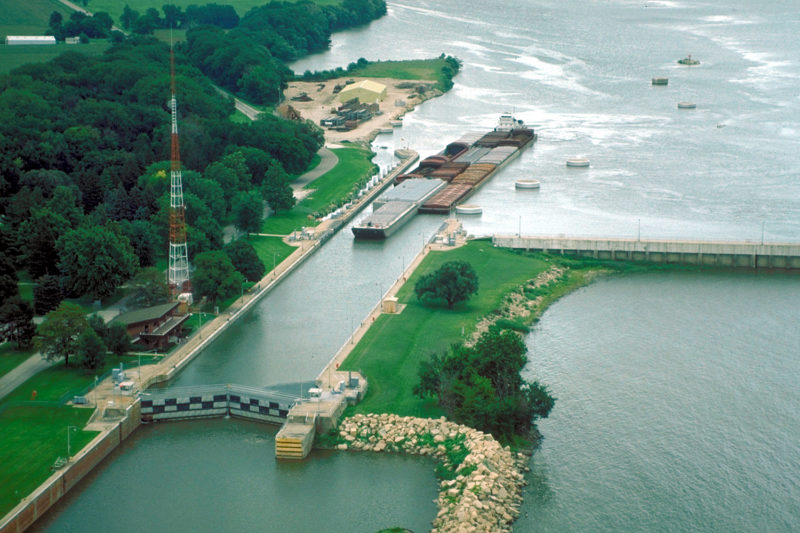Barge operators that use the Illinois Waterway will face the first round of closures in June as preliminary work begins on major repairs to six of eight lock and dam sites along the system that will begin next summer and carry into 2023.
In preparation for significant work next year, bulkhead slots will be installed at Marseilles and Starved Rock locks this summer, requiring a partial closure and width restrictions for 92 days. A full lock closure will then occur for 14 days to install the sill beam across the bottom of the lock chambers, according to the Corps of Engineers’ Rock Island District.

Closures will start this summer as the Corps of Engineers makes improvements on the Illinois Waterway. Corps of Engineers Rock Island District image
Starting June 1 through Aug. 15, the locks will be closed to navigation during the day beginning at 6 a.m. to 6 p.m., seven days a week. The locks will be open at night until 6 a.m. the next morning, but with a 70’ width restriction in place at both locations. The closures will be suspended from July 3-7 to allow for holiday pleasure boat traffic.
Then on Aug. 16 through Aug. 29, the locks will be closed to all navigation.
Severe spring flooding and high water along the inland waterways system that forced many lock and dam closures will not affect the summer schedule, said Allen Marshall, chief of corporate communications at Rock Island.
The 120-day closure planned for summer 2020, an unprecedented event, will start on July 1, as long as river levels cooperate, the Corps said.
The Illinois Waterway is a busy portion of the inland system, providing a shipping connection from the Great Lakes to the Gulf of Mexico via the Illinois and Mississippi rivers. It includes eight lock and dam sites that were built in the 1930s and need significant repairs. The closures are expected to affect barge lines, shippers, business owners and farmers in the movement of agricultural commodities like corn and soybeans as well as fertilizer.
The Corps chose the June-October time frame so that work could be done outside the spring flooding season and before the grain harvest gets underway. The Corps said it preferred to close the locks simultaneously in one year rather than disrupting commercial navigation over several years.
The biggest project will be dewatering the lock chamber to perform major rehabilitation and maintenance at the LaGrange Lock and Dam in Versailles, Ill., a top priority for the Corps. The antiquated and badly worn lock gate machines will be replaced and significant repairs will be made to the crumbling concrete and steel structures of the lock chamber.
These repairs will close La Grange from July 1 to Sept. 30, 2020, and are needed to prevent more unscheduled and prolonged outages due to mechanical and structural failures.
LaGrange is the busiest lock on the river, with some 30 million tons of products moving through each year.
Additionally, the Peoria Lock and Dam will undergo inspections and maintenance of submerged areas for 60 days starting in mid-July. Meanwhile, dewatering and installation of miter gates will be done at the Starved Rock Lock and Dam and the Marseilles Lock and Dam from July 1 to Oct. 30. Prep work will also be done at the Dresden Lock and Dam and the Brandon Road Lock and Dam, installing bulkhead slots to the existing emergency gates. In July 2023 these locks and dams will get new gates.
The closures are actually a good sign that Congress is appropriating money to repair the nation’s antiquated – and in many spots, crumbling – inland river infrastructure that is far beyond its 50-year design life. Many locks and dams are 80 to 90 years old.
Although repairs were made along the Illinois Waterway in the 1980s and 1990s to add another 25 years of service, much of the machinery, concrete and gates are original, and have decayed in decades of freeze-thaw cycles and normal use, wrote Tom Heinold, chief of the Operations Division at Rock Island, wrote in the May 4 issue of the Waterways Council newsletter.
Completion of the new, wider Panama Canal locks is expected to put even more demand on the Illinois Waterway and Upper Mississippi River system to move soybeans and corn for export, according to Heinold.
During the closures, alternate means of transportation will have to be planned for, such as rail or barging commodities along the Mississippi River through St. Louis, Mo.
Another option would be to accelerate shipping before and after the closures, or stockpiling products that are not time sensitive. Those decisions will likely be governed by the cost of shifting from barge to other transportation modes.
The Corps predicts that it could take the navigation industry two or more years to fully recover from the impact of the closures.
This summer’s closures will be a good trail run for how things will play out next year, Corps officials said.
For more information, listen to the Corps’ webinar about the closures at:
http://www.mvr.usace.army.mil/Media/Images.aspx?igphoto=2002096262



.JPG.small.400x400.jpg)

